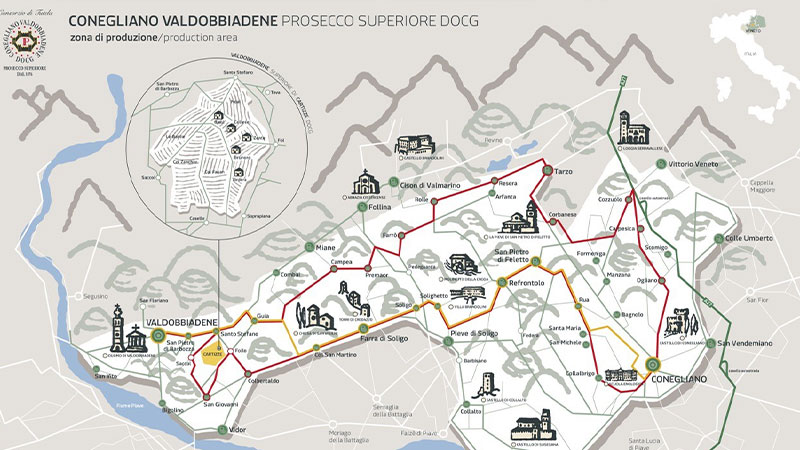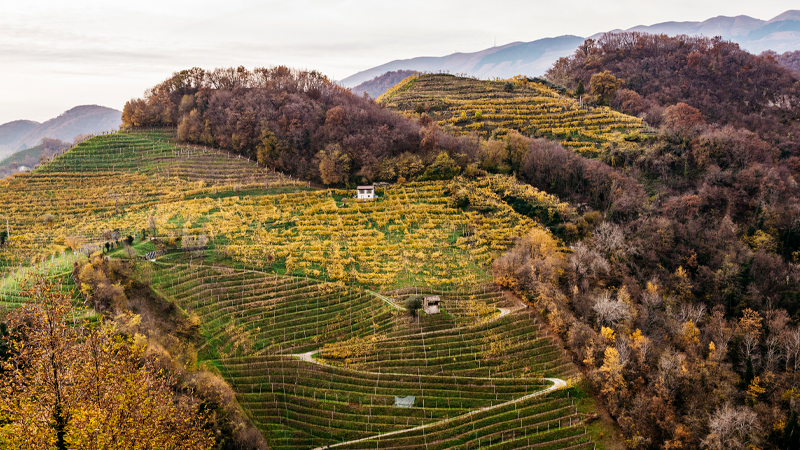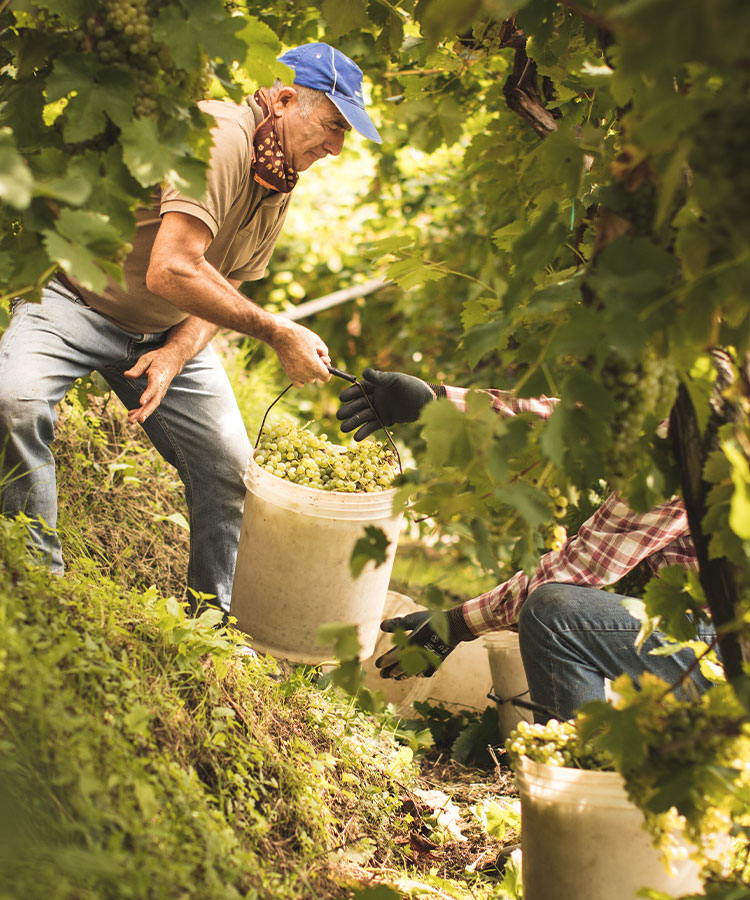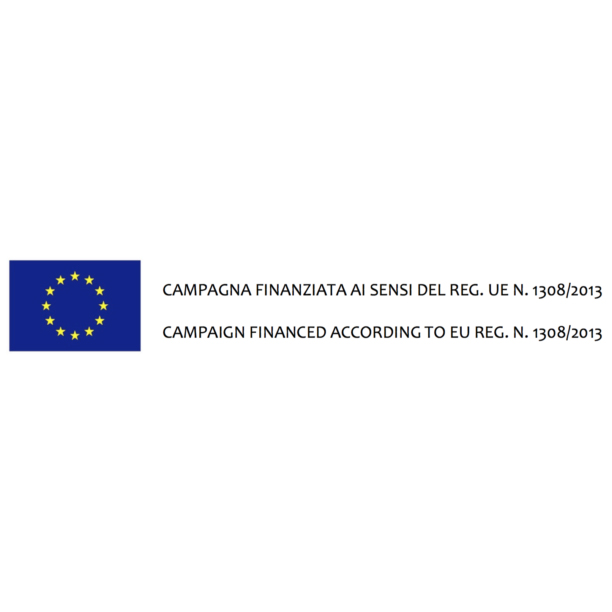
You’d be hard-pressed to find someone who doesn’t love a glass of Prosecco, Italy’s famed sparkling wine. The fruit-forward bubbly is a crowd pleaser everywhere from Sunday brunch and summer picnics to wedding toasts and romantic date nights. However, for all of Prosecco’s popularity, it often doesn’t get the attention it deserves when it comes to understanding the intricacy of the style, star grape variety, and region. Namely, not all Prosecco is created equal.
Technically, Prosecco can be made in nine provinces of Italy’s northern region of Veneto, but it’s in high altitudes of the Treviso province of Veneto where Glera, the main grape of Prosecco, really flourishes. It’s here you’ll find the most historical and best expressions of Prosecco, including the touted region of Conegliano di Valdobbiadene, known for the top Prosecco in the world. It’s one of Italy’s 74 wines listed with the heralded Denominazione di Origine Controllata e Garantita (DOCG) designation. The strict set of requirements to be labeled Prosecco Superiore DOCG means you, the consumer, are getting top-notch bubbly. Everything else must be labeled DOC, with less stringent rules for production and quality.

“We like to describe it as a quality pyramid — DOCG represents the highest echelon of that pyramid,” explains the Consortium for the Protection of Conegliano Valdobbiadene Prosecco DOCG. “This is where the Prosecco that we know today all over the world was invented. This is where it all began.”
Conegliano di Valdobbiadene would not garner the exclusive DOCG status if it didn’t earn it. The area stands apart due to its altitude, terroir, and winemaking styles. It sits, quite literally, above the rest of Prosecco, overlooking steep slopes full of vines. It’s actually so picturesque and historically significant that in 2019, the hilly landscape was named a UNESCO World Heritage site.
The hilly countryside is only a 45-minute drive from Venice, and has a long history akin to the significant maritime city. Conegliano di Valdobbiadene has a vine-growing timeline that dates back to antiquity, with sparkling wine made in the region since the early 1770s.
Glera makes up 85 percent or more of the Prosecco blend. This white grape grows particularly well on the high hilltops ranging from 100 to 500 meters above sea level, where the diurnal temperature swings allow for optimal ripening through the growing season. The gradient of the hillsides manages the rainwater flow, and the mild climate ensures a gentle breeze to prevent over-ripening on sunny days.
Where the region really merits distinction is its unique soils, which contribute to the complexity in bottles labeled Conegliano Valdobbiadene Prosecco Superiore DOCG. The area, once covered by glaciers, now features an assorted set of soils. Glaciers from the nearby Dolomite mountains brought sediment downhill, which mixed with the marine soils already there. That resulted in a composite of rock and sand, marl and sandstone, with some patches more porous than others.
Winemakers in the region use these differences in altitude and soil types to their advantage, blending grapes from various parts of the vineyards into their bottlings. You can taste the difference. These wines show more complexity of flavors and aromas, and often have more balanced acidity and a longer finish than your average bottle of Prosecco.
Those same glaciers contributed to the shapes of the hillsides, leaving some more steep than others, and crafting a series of micro-zones that today hold special designations for Prosecco. Two such zones lie within Conegliano di Valdobbiadene DOCG: Rive DOCG and Cartizze DOCG.

“Rive” in the local dialect translates to “steep slopes” and it’s emblematic of specific slopes throughout Conegliano Valdobbiadene that produce high-quality grapes. There are 43 micro-zones throughout the appellation that are designated with Rive DOCG — each with its own expression of the soil, sun exposure, and microclimate. The regulations for production vary slightly from Prosecco Superiore DOCG. For instance, the yields per hectare are lower, and the grapes are exclusively hand-harvested. Most notably, you’ll always see the vintage on the label.
While Rive is found throughout Conegliano di Valdobbiadene, Superiore di Cartizze DOCG comes from a tiny (tiny!) sub-zone outside the town of Valdobbiadene that’s just one-third the size of New York City’s Central Park, and is among Italy’s most expensive land per hectare. But this small collection of hilly vineyards holds a big reputation for being the preeminent Prosecco in the world. Some of the steepest slopes are found in this pocket, and it is known for producing elegant and refined Proseccos. They may be hard to find, but if you do snag one, they are worth popping the bottle.
Cartizze is also among the oldest areas for Prosecco production as we know it today. Winemakers from Cartizze, along with others from Conegliano di Valdobbiadene, banded together in the early 1960s to form a Consortium to lobby the Italian Ministry of Agriculture to recognize and protect Prosecco as an official Italian wine. In 1969, the methodology and requirements were codified.
Today, the Consortium still advocates on behalf of the 192 Prosecco producers and 3,357 growers and helps expand the message of quality Prosecco around the world. Elvira Bortolomiol, the daughter of one of the founders of the Consortium, recently took over as President with aims of continuing to to enhance the environmental sustainability of the region’s vineyards as well as increasing the competitiveness of Prosecco in the global market.

One hurdle for the American consumer is the fact that DOCG Prosecco often costs double its DOC counterpart ($30 to $40), with Rive bottlings clocking in somewhere in between, around $20 to $25. Given that many consumers are drawn to the Prosecco category due to its sub-$15 price point, the consortium has made it a big part of its plan to explain why it’s worth shelling out the extra cash.
“Part of our mission as a Consortium is to make consumers understand why a Conegliano Valdobbiadene Prosecco Superiore DOCG is a superior product, why it is worth spending more for a quality sparkling wine,” the Consortium says. “Actually, once you’ve tasted it, it is quite simple to be persuaded.”
This article is sponsored by Consorzio Tutela del Vino Conegliano Valdobbiadene Prosecco Superiore.

